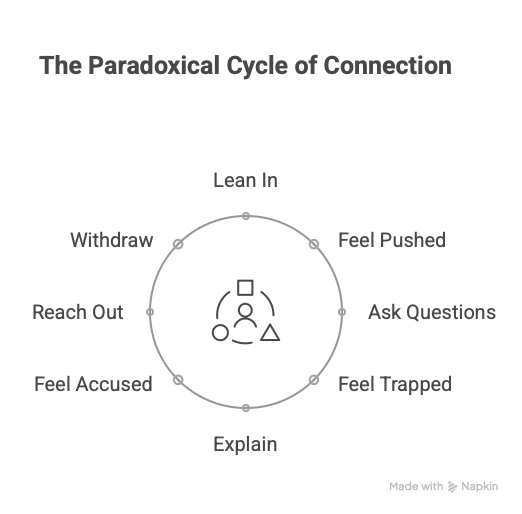Chasing Connection Will Push It Further Away
Why your pursuit isn’t bringing you closer… and what to do instead
We all crave connection.
We long to feel close, secure, seen, and chosen—especially by the person we’ve committed our life to. So when connection starts to slip, the instinct is simple and human: go get it back.
Say more.
Try harder.
Reach out.
Explain again.
Ask for reassurance.
Ask for a plan.
Ask if they still care.
And when that doesn’t work, what then? We push a little harder. We plead a little louder. We analyze, reword, follow up, and reach out again.
It’s easy to justify these efforts. After all, what’s wrong with trying to make things better?
But here’s the hard truth: If your spouse is pulling away, chasing connection often drives them further.
It doesn’t mean you’re too much.
It doesn’t mean you’re needy.
It doesn’t mean you’re wrong for wanting more.
It just means that your pursuit is triggering something deeper in the system you both share. And if you don’t understand that system, you’ll stay stuck in the exhausting cycle of trying to hold together what keeps slipping from your hands.
Let’s unpack what’s really going on. And more importantly, what to do instead.
Why Chasing Backfires
The reason chasing doesn’t work isn’t because your desire is wrong. It’s because chasing flips the emotional polarity between two people.
In a healthy connection, there’s a mutual dance of closeness and space. One person moves slightly in, the other slightly out, but there’s a rhythm. A pulse. A sense that both people are choosing to be there, willingly.
When one person starts pulling away—emotionally, physically, or otherwise—the rhythm breaks.
And when you rush in to restore that connection, it doesn’t look like closeness anymore. It looks like pressure.
The more you lean in, the more they feel pushed.
The more you ask, the more they feel trapped.
The more you explain, the more they feel accused.
The more you reach, the more they withdraw.
What started as a longing for closeness is now experienced as control.
And here’s the kicker: The more emotionally important someone is to us, the more sensitive we are to their pull. So what feels like a loving pursuit to you often lands as an overwhelming demand to your spouse.
The Chaser/Spacer Dynamic
This dance has a name: the Chaser/Spacer dynamic.
It happens in all kinds of relationships, but especially in romantic ones. One partner (the Chaser) is more sensitive to disconnection and pursues closeness to feel secure. The other (the Spacer) experiences that pursuit as invasive and moves away to preserve autonomy or emotional safety.
It’s not about fault.
It’s about pattern.
In fact, most people aren’t always Chasers or always Spacers. They might switch roles depending on the relationship or situation. But in a struggling marriage, these roles tend to harden.
And the more stuck each person feels, the more extreme they become:
The Chaser becomes more desperate, anxious, and intense.
The Spacer becomes more distant, avoidant, or defensive.
The tragic irony? Both are hurting. Both want peace. Both are afraid.
But neither can see the other clearly anymore.
Why We Chase (Even When It Doesn’t Work)
If you’ve found yourself stuck in the Chaser role, there’s probably a good reason.
You might be someone who values communication and clarity. You believe that if we just talk it out, we can fix it.
You might come from a background where connection was uncertain, so you learned to monitor and manage the emotional tone of others to feel safe.
You might be the one who sees the marriage slipping away, and you feel like you’re the only one trying.
Of course you’re reaching out. Of course you’re asking questions. Of course you’re trying to hold it together.
But here’s the reality:
Chasing doesn’t lead to closeness. It leads to collapse.
And when you finally collapse — tired, bitter, resentful, exhausted — nothing has changed. The connection hasn’t been repaired. It’s just been pushed further out of reach.
So what do you do instead?
Becoming the Pacer
There’s a third option between chasing and withdrawing.
I call it becoming a Pacer.
The Pacer holds steady.
The Pacer honors both connection and space.
The Pacer doesn’t pursue, but doesn’t disappear, either.
Where the Chaser is reactive and urgent, the Pacer is responsive and calm.
Where the Spacer disconnects to feel safe, the Pacer stays grounded to create safety.
Becoming a Pacer means you stop trying to force closeness, and start becoming someone safe to come close to.
You stop focusing on controlling the relationship and start focusing on regulating yourself.
This is how connection begins to feel possible again.
How to Shift From Chaser to Pacer
Here are a few powerful shifts that can move you out of the Chaser role and into a more grounded, steady presence:
1. Pause the Pursuit
Before reaching out again, ask yourself:
Am I trying to get a response—or am I offering connection?
Chasers often act from anxiety, not alignment. So before sending that message or initiating another talk, breathe. Wait. Let your nervous system settle. Let your next move come from clarity, not panic.
2. Lead with Calm, Not Crisis
Connection isn’t built in crisis mode.
Start treating your interactions less like emergencies and more like invitations. A quick “Hey, no pressure, just wanted to say hi” is miles more effective than a five-paragraph emotional plea.
3. Tag-Along Invitations
Instead of asking “Can we talk?”, invite them to something you’re doing anyway:
“Hey, I’m going to grab coffee. Want to come with me?”
“I’m watching that movie you like. Want to join me?”
These “tag-along” moments lower the stakes and give space to reconnect without pressure.
4. Rebuild Emotional Safety
Your spouse may not feel emotionally safe around you right now. Not because you’ve done something horrible, but because intensity feels threatening when someone’s guard is up.
So turn the volume down.
Lower the emotional temperature.
Become someone who’s easy to be around.
That might mean fewer deep talks and more shared silence.
Less probing, more presence.
5. Work Your Side of the System
Focus on how you show up in the system. You don’t have to fix the whole marriage to change the energy between you. One grounded presence has more power than you think.
What If Nothing Seems to Work?
If you’ve tried pacing, giving space, backing off—and still feel stuck—it’s important to remember this:
You can shift the system without controlling the outcome.
That’s the tension. That’s the work.
To lead with steadiness even when there’s no immediate payoff.
To live in integrity even when the future is unclear.
To become safe, strong, and self-led—even if they’re not ready yet.
This isn’t passive waiting.
It’s active becoming.
Want Help Making the Shift?
If this article hit home and you recognize yourself in the Chaser role, you’re not alone. And you’re not helpless.
I’ve created several resources that can guide you step-by-step toward connection without chasing:
🔹 Chaser, Spacer, or Pacer
Understand the dynamic you’re in and how to shift your role. Includes a simple quiz, clear explanations, and concrete strategies for becoming a Pacer.
🔹 Reconnect Without Chasing
A complete playbook with audio trainings and a beautifully designed workbook to help you balance space and connection—even if your spouse is pulling away.
🔹 Simple Actions
Feeling stuck? Start small. This guide gives you 20+ short, doable actions (most under 10 minutes) to begin shifting the emotional tone between you.
These aren’t about manipulating your spouse.
They’re about helping you become a steadier, wiser, more grounded version of yourself—one that invites connection, without chasing it down.
Final Word
Wanting connection is not the problem.
Trying to hold onto love is not the mistake.
But how you respond to disconnection matters deeply.
You can’t force intimacy.
You can’t chase someone into closeness.
But you can become someone worth returning to.
And that, more than anything, is how relationships begin to heal.



